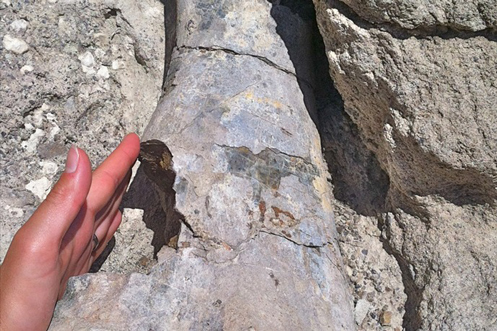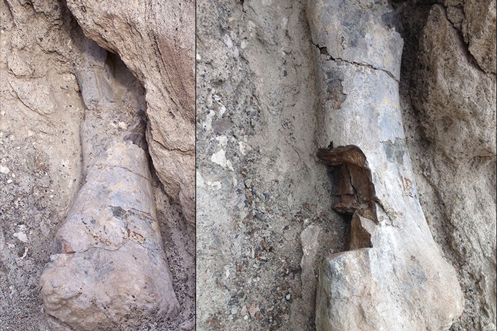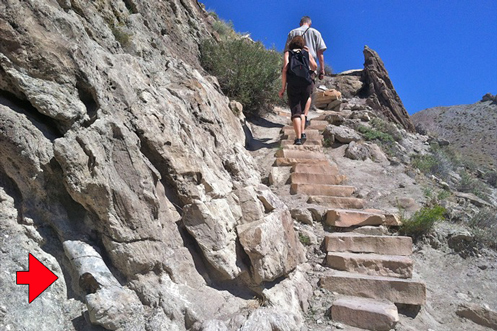Dinosaur Fossil Damaged and a Piece Stolen from Dinosaur National Monument
It once was a near perfect fossil of the upper arm bone of a sauropod dinosaur, now it is broken and damaged with a fist-sized chunk missing. Rangers at the Dinosaur National Monument in Utah have reported the vandalism and theft of part of a humerus. It is extremely sad to have to report on yet another theft of a dinosaur fossil, officials at the Monument are appealing to members of the public to help them trace the culprit(s).
The Damaged Portion of the Dinosaur Fossilised Bone
Picture credit: National Parks Service
The picture above shows the missing section of the dinosaur bone, the bone seems to have been deliberately smashed.
Dinosaur National Monument
The Dinosaur National Monument is well-named. Managed by the United States Department of the Interior National Parks Service, the park covers some 85,000 hectares and overlies the border between the states of Colorado and Utah (although the main dinosaur quarry site is in Utah, close to the town of Jenson). The Monument is world famous for its amazing collection of dinosaur and other vertebrate fossils which date from the Upper Jurassic.
At least ten different types of dinosaur genera are known from the Morrison Formation exposures. The Utah sequence represents high energy riverine deposits and on show at the visitor centre is a sandstone “wall” that reveals some 1,500 dinosaur bones. Dinosaurs were probably swept away and drowned during floods. At bends in the river as the current slowed down, so debris, including the carcases of dinosaurs was deposited. The Dinosaur National Monument preserves these “log jams” of dinosaur bones. Genera associated with the Monument include Camarasaurus, Allosaurus, Stegosaurus, Apatosaurus, Diplodocus and Dryosaurus.
The Fossil Discovery Trail
On Tuesday, September 2nd , a park ranger was leading a tour party along the Fossil Discovery Trail when the damaged bone was noticed. The vandalism and theft probably took place sometime between the Monday guided walk along the Fossil Discovery Trial and Tuesday morning. The Fossil Discovery Trail is a 1.2 mile trail that runs between the Quarry Visitor Centre and the Quarry Exhibit Hall where the famous sandstone “wall” of dinosaur bones that we described above, is located.
The trail is unique as it is one of the few places where visitors can hike to see and touch dinosaur fossils and fragments in situ. It allows visitors to experience what it may have been like for palaeontologist Earl Douglass (Carnegie Museum of Natural History), when he discovered the first fossils in what is now the Monument.
A spokesperson from Everything Dinosaur commented:
“This is such a shame as the Dinosaur National Monument is going to celebrate its centenary next year and to have fossils damaged and stolen is deeply upsetting. Although the fossils along the trail are of limited scientific value they provide a wonderful opportunity for members of the public to get up close to real dinosaur fossils.”
The Sauropod Humerus (before and after) Photographs
Picture credit: National Parks Service
The picture above shows two photographs, the picture of the humerus without the damage (left) and a close up showing the damaged portion (right). Although our dinosaur experts cannot be certain, the bone portion in question looks like the distal end of a left humerus, probably part of a Camarasaurus. Park officials are seeking help from the public and anyone with information regarding this theft are invited to contact staff on (435) 781-7715. A reward of $750 USD has been put up by the Intermountain Natural History Association for information that leads to a conviction.
The Part of the Fossil Discovery Trail where the Bone was Situated
Picture credit: National Parks Service
Not to Collect or Damage Fossils
Everything Dinosaur would like to take this opportunity to stress that visitors to the Dinosaur National Monument are not allowed to collect/damage any fossils or rocks. Under Federal law, all features, artefacts and resources are protected. No collection of park geological resources for commercial sale, private collections or for classroom educational purposes is permitted. We advise all visitors to National State Parks of America to familiarise themselves with the various protection laws and polices that relate to that particular location.









Leave A Comment